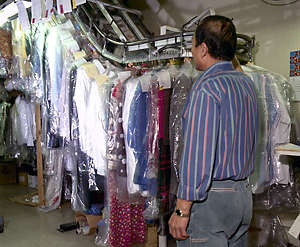
 |
|
 How Does a Dry Cleaner Wash Your Clothes? There are two types of garment cleaning: wet cleaning and dry cleaning. Dry cleaning is suitable for delicate fabrics and other clothes which cannot be washed by water. Dry cleaning is a method to wash dirt and stains by using a solvent instead of water. This is a very effective way to remove fatty stains, without changing the garment shape and altering the texture and the color of the fabric materials. Dry cleaning is less effective for washing dirts that are easily soluble in water. What is Dry Cleaning? Dry cleaning uses fluids to remove soil and stains from fabric. In fact, the term "dry cleaning" is misleading; it is called dry cleaning because the fluid contains little or no water and does not penetrate the fibers as water does. Among the advantages of dry cleaning is its ability to dissolve greases and oils in a way that water cannot. Drycleaning helps to return garments to a "like-new" condition using precautions to prevent shrinkage, loss of color, and fabric distortion. The dry cleaning process begins with the pretreatment of spots and stains using special cleaning agents. The garments are then loaded into a machine resembling an oversized front-loading home washer. Throughout the cleaning process the fluid is filtered or distilled to ensure its clarity. Today, the solvent used by almost 90% of all dry cleaners is perchloroethylene, commonly known as "perc." It is completely non-flammable and non-combustible, of relatively low toxicity, and can be efficiently reused and recycled. What is wet cleaning? Wet cleaning starts with the pretreatment of spots and stains using special cleaning agents. Wet cleaning is the process of removing soils from garments and other textile items through the use of water and additives (such as detergent) and using precautions to prevent shrinkage, loss of color, and fabric distortion. What is laundering? Special detergents, additives, and finishes sets commercial laundering apart from home laundering. This process enables your cleaner to offer consistent quality shirts at reasonable prices. Make the Following Checks When Sending Clothes to a Dry Cleaner:
In 1997, the Laundry and Drycleaning Association received 558 complaints from the public regarding damages made to their clothes in cleaning. The breakdown of the damage complaints and the parties who were found responsible are indicative. Among damages for which the clients were responsible, the most common was the "change of color" amounting to 66 % of the total cases. Cases of stains made by spilled bleach or damages caused by inappropriate storage are on the increase recently at individual homes. It is important that the consumers also have the basic knowledge about how to clean and keep clothes in good shape. Professional Cleaning Steps Professional cleaning involves many different operations, all performed by skilled people and designed to give your garments a fresh and clean appearance. Procedures include:
The Importance of Care Labels The Federal Trade Commission (FTC) requires that manufacturers attach a permanent care label to textile garments to provide directions for their care. Manufacturers must list at least one method of safe care for a garment. The rule covers all textile clothing except footwear, gloves, hats, suede and leather clothing, and household items such as linens. The rule stipulates that the care label is easily found, will not separate from the garment, and will remain legible for the garment's useful life. The label must warn about any part of the recommended care method that would harm the garment of other garments cleaned with it. It must also warn when there is no method for cleaning a garment without damaging it. Symbols also may appear on a care label to supplement written instructions. If a label indicates dry cleaning, all components of the garment, including the outer shell, lining, buttons, interfacing, fusing material, and trim, should be colorfast and remain unaltered during cleaning. If any such problem occurs, it is the responsibility of the manufacturer. If you or your cleaner follow the manufacturer's instructions and the garment is damaged, you should return the garment to the store and explain what happened. If the store will not resolve the problem, write to the manufacturer and send a copy of your complaint letter to the FTC. The information you provide the FTC may reveal a pattern or practice requiring the Commission's attention. If you purchase a garment with no care label, you should contact the FTC, giving the name and address of the store and manufacturer. Occasionally, damage done in dry cleaning is the responsibility of the dry cleaner and not the result of preexisting conditions or defects. In such cases, the cleaner will usually settle the claim promptly and fairly, often using IFI's Fair Claims Guide. If there is some doubt about responsibility, the member cleaner can send the garment to IFI's Garment Analysis Laboratory to determine the cause of the problem. How Can You Help Your Clothes and Your Cleaner?
|
|
Don't miss our money-saving specials!  Visit our Coupons page. |